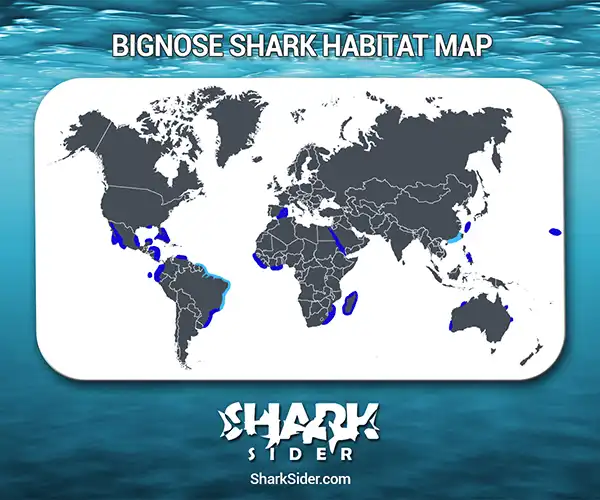Bignose sharks are a species of deepwater requiem sharks belonging to the family Carcharhinidae. Also known as Knopp’s sharks, they are distributed globally and often cover long distances for migration.
Bignose Shark Scientific Classification |
|
| Kingdom | Animalia |
| Phylum | Chordata |
| Class | Chondrichthyes |
| Order | Carcharhiniformes |
| Family | Carcharhinidae |
| Genus | Carcharhinus |
| Scientific Name | Carcharhinus altimus |
Description
The bignose appears big and heavy, with one of its major distinguishing features being its snout – broad, blunt, and long. Another highlighting trait, which even results in their name is these shark’s prominent triangular-shaped nasal flaps. Their eyes appear moderately large, circular-shaped with a nictitating membrane functioning as a third eyelid.
Males and females of this species can grow up to 8.9 and 9.2 ft long, respectively. The longest shark ever caught measured a record, 9.8 feet. The maximum weight on record is 370 lbs.
The bignose has a grayish or bronze coloration on the upper side and white on the undersides. The tips of the inner corners of the pectoral fins are black. A faint pale stripe is visible on the flank.
They have a broadly curved mouth and five pairs of long gill slits. The dermal denticles in their skin are oval and closely spaced but non-overlapping. Each denticle has three horizontal ridges leading to marginal teeth.
The upper jaw consists of 14-16 rows of tall, broad, serrated teeth on both sides, which are triangularly cusped. There are also 1-2 small teeth in the midpoint of the upper jaw (symphysis).
There are between 14 or 15 narrow teeth with finely serrated margins and narrow serrated cusps in the lower jaw.
This species has long, straight pectoral fins and a prominent ridge between its two dorsal fins.
The first dorsal fin is large, bluntly pointed, and originates on top of the pectoral fin base. Their second dorsal fin is larger than the first and has a short rear tip.
The anal fin is located slightly behind that of the second dorsal fin.
Where do they live
Map Of The Bignose Shark’s Habitat

They inhabit the waters of the western Atlantic from Florida in the USA to Venezuela to the eastern Atlantic Ocean from Senegal to Ghana, including the Mediterranean Sea.
Its numbers range across the western (China and Taiwan to Australia), central (Hawaii), and eastern (from the Gulf of California, southern Mexico to Colombia and Ecuador) the Pacific Ocean.
They are also spotted in the Indian Ocean (especially in the seas of South Africa and Madagascar), the Red Sea, India, and the Maldives.
Commonly spotted in coastal parts of Florida and the Bahamas, these creatures are rarely seen on the Mediterranean and Brazilian coasts.
The bignose sharks inhabit the edge of continental shelves and insular slopes. They usually swim close to the sea floor and are located at depths of 300–1,410 ft, though at night, they may move near the water surface or into shallower water.
They prefer climates of tropical and subtropical waters and undergo a seasonal migration in the summer.
They are known to cover distances of 1000-2000 miles.
Behavior
Dietary
The general diet of the bignose shark consists of bottom-dwelling bony fishes such as mackerels, croakers, lizardfishes, batfishes, and flatfishes. It also feeds on cartilaginous fishes such as stingrays, dogfishes, catsharks, and chimeras. These sharks even consume cephalopods such as squids and small octopuses.
Reproductory
Bignose sharks are viviparous as the embryos get nourishment and exchange gases via a placental sac. The female gives birth every second year, and the time of giving birth varies with their geographical distribution. The gestation period lasts up to 10 months, after which the females deliver 1-13 pups in a litter, each measuring 27.5-35.4 inches. Males mature at 7.1 feet, and females between 7.4 and 9.3 feet. These sharks become reproductively active at around 21 years of age.
Adaptations
This shark has a nictitating membrane atop its eyelids which acts as a third eyelid. It helps protect the eye while attacking prey and from ultraviolet radiation.
Interactions with humans
The bignose shark is a large deepwater species and very rarely comes in contact with humans and doesn’t pose a threat to them.
These sharks are harvested in the Caribbean region with deep longlines and utilized for their oil or meat, which is used as fish meal or animal feed. This species is prohibited from being captured in the U.S. commercial shark fisheries.
It has been listed as ‘Near Threatened’ by the IUCN. Overfishing and accidental killing of these sharks by offshore trawlers and hook and line have placed a general concern on this species. The fact that the bignose shark has a slow reproductive rate adds to the growing crisis. In Australia it is considered as Least Concern since the bignose is under no risk there.
